PACKARD BELL LV11HC Quick Start Guide [en, fr, de, it, es, ru, pl, cs]
English
Français
Deutsch
Italiano
Español
Português Nederlands Norsk Dansk Svenska Suomi
Русский
Polski
Magyar Čeština Slovenčina Română
Български
Ελληνικά
Türkçe
Eesti Latviski Lietuviškai
Contents
Ver.02.01.03
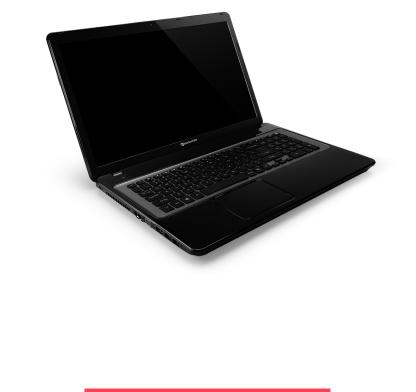
Quick Start Guide
Packard Bell EasyNote LV
TABLE OF CONTENTS
Starting your computer |
3 |
Wireless connection........................................... |
3 |
Registration........................................................ |
3 |
Software installation........................................... |
4 |
Recovery............................................................ |
4 |
Having trouble?.................................................. |
4 |
Getting to know your computer |
5 |
Top view - display .............................................. |
5 |
Top view - keyboard .......................................... |
6 |
Special keys ............................................... |
6 |
Front view .......................................................... |
8 |
Left view............................................................. |
9 |
Right view ........................................................ |
10 |
Base view ........................................................ |
11 |
Touchpad |
12 |
Touchpad basics.............................................. |
12 |
Touchpad gestures .......................................... |
12 |
Recovery |
13 |
Creating a recovery backup ............................. |
13 |
Creating a drivers and applications backup ..... |
15 |
Recovering your system .................................. |
16 |
Reinstalling drivers and applications ........ |
17 |
Returning to an earlier system |
|
snapshot ................................................... |
19 |
Returning your system to its factory |
|
condition ................................................... |
19 |
Recovering from Windows........................ |
19 |
Recovering from a recovery backup ......... |
22 |
Regulatory information |
24 |
Environment |
34 |
Software license |
36 |
Table of Contents - 1

Copyright © 10/2012.
All Rights Reserved.
Packard Bell EasyNote TV Quick Guide
This revision: 5 October 2012
Work Great with Microsoft® Office 2010 - Express your ideas, solve problems and simplify everyday projects with Office 2010.
Photo editing - Easily edit and print your photos with Windows Live Photo Gallery. Then share them on Facebook, YouTube™ or Windows Live.
Search & Decide with Bing™ - Find and organize the answers you need using Bing™, so you can make faster, more informed decisions.
Please use this space to write down important information about your computer.
Product name: . . . . . . . . . . . . . . . . . . . . . . . . . . . . . .
Serial Number: . . . . . . . . . . . . . . . . . . . . . . . . . . . . . . .
Date of purchase: . . . . . . . . . . . . . . . . . . . . . . . . . . . .
Place of purchase: . . . . . . . . . . . . . . . . . . . . . . . . . . . .
Visit registration.packardbell.com and discover the benefits of being a customer of Packard Bell.
Remark: All images are for reference purposes only. Actual configuration may vary.
2 - Quick start guide

STARTING YOUR COMPUTER
Thank you for purchasing this Packard Bell computer!
This guide has been designed to introduce you to the features of your computer and assist in your computing experience.
After setting up and starting your computer, as shown in the setup instructions, it will ask you questions that will help you connect to the Internet. Your computer will then configure installed software.
WIRELESS CONNECTION
To connect to a wireless network, first check the wireless features of your computer are on, and that the router or modem you want to connect to is also correctly configured.
•If wireless is not on, press the Windows key (  ) + W, type "Wireless" and then click on Wireless. Click the toggle switch under Wi-Fi to enable the wireless connection. Click again to disable.
) + W, type "Wireless" and then click on Wireless. Click the toggle switch under Wi-Fi to enable the wireless connection. Click again to disable.
•To connect to a network, press the Windows key (  ) + W, type "Wireless" and then click on Connect to a network. Select your network and enter the password if required.
) + W, type "Wireless" and then click on Connect to a network. Select your network and enter the password if required.
•After a short delay, your computer should connect to the Internet.
If your network is not detected, or your computer does not connect to the Internet, please refer to your ISP or router’s documentation. After your computer starts and you can use it, open Internet Explorer and follow the instructions.
Alternatively, use a network cable to connect directly to a network port on your router. Please refer to your ISP or router’s guide.
REGISTRATION
When using your computer for the first time, it is recommended that you register it. This gives you access to some useful benefits, such as:
•Faster service from our trained representatives.
•Membership in the Packard Bell community: receive promotions and participate in customer surveys.
•The latest news from Packard Bell.
How to register
During the initial startup of your computer, a window will invite you to register. Please fill in the information and click Next. The second window you'll see contains optional fields that will help us to provide you with a more personable customer service experience.
Starting your computer - 3
Another option
Another way to register your Packard Bell product is to visit our website at registration.packardbell.com. Choose your country and follow the simple instructions.
After registering, you will be sent a confirmation email with important information that you should keep in a safe place.
SOFTWARE INSTALLATION
Your computer will automatically install software and prepare your computer for use. This may take some time, please do not turn off your computer; wait until the installation has finished.
RECOVERY
You should create recovery discs as soon as you are able. The Packard Bell Recovery Management program allow you to create recovery discs and then to restore or reinstall applications and drivers provided by Packard Bell.
HAVING TROUBLE?
Packard Bell provides several options to support your purchase.
Packard Bell support
Make sure you write down your computer serial number, date and place of purchase and model name on the area provided in this guide; save your proof of purchase. Before you call us, please write down any error message that accompanies the problem, and have the computer in front of you and switched on if possible. Having these items to hand when contacting us will ensure better and quicker service.
Packard Bell website
Remember to visit www.packardbell.com - Check out the support section for up-to-date information, help, drivers and downloads.
Warranty and contact information
You can find information about the warranty for your computer and how to contact technical support in your computer’s Warranty.
4 - Quick start guide
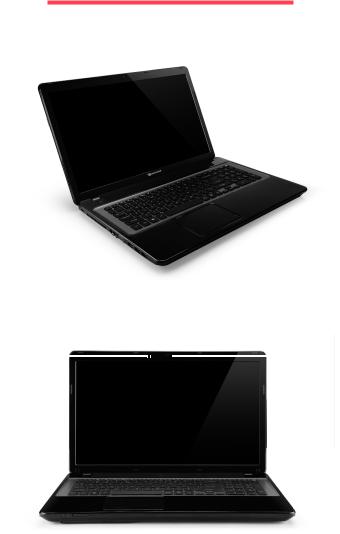
GETTING TO KNOW YOUR
COMPUTER
After setting up your computer, as illustrated in the setup instructions, let us show you around your new Packard Bell computer.
Packard Bell EasyNote LV
TOP VIEW - DISPLAY
1 |
3 |
 2
2
# |
Icon Item |
Description |
|
1 |
Microphone |
Internal microphone for sound recording. |
|
|
|
|
|
2 |
Display screen |
Also called Liquid-Crystal Display (LCD), |
|
displays computer output. |
|||
|
|
||
|
|
|
|
|
|
Web camera for video communication. |
|
3 |
Webcam |
A light next to the Webcam indicates that the |
|
|
|
webcam is active. |
|
|
|
|
Getting to know your computer - 5
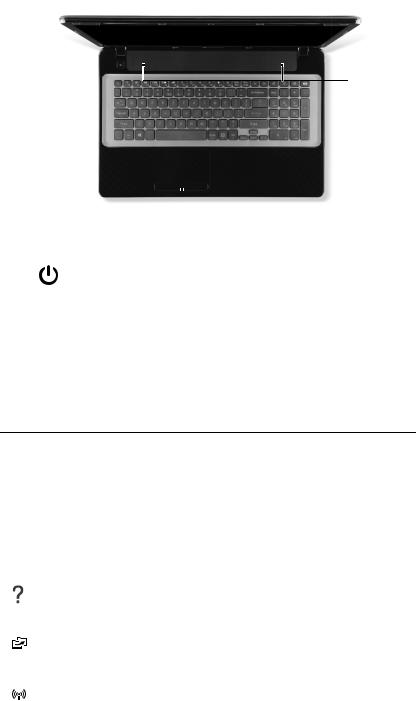
TOP VIEW - KEYBOARD
1
5
2
3
 4
4
# |
Icon Item |
Description |
|
1 |
Power button / |
Turns the computer on and off. Indicates the |
|
indicator |
computer's power status. |
||
|
|||
|
|
|
|
2 |
Keyboard |
For entering data into your computer. |
|
- Special keys are described on page 6. |
|||
|
|
||
|
|
|
|
3 |
Touchpad |
Touch-sensitive pointing device which |
|
functions like a computer mouse. |
|||
|
|
||
|
|
|
|
4 |
Click buttons (left |
The left and right side of the button function as |
|
and right) |
left and right selection buttons. |
||
|
|||
|
|
|
|
5 |
Speakers |
Deliver stereo audio output. |
- Note: The front panel indicators are visible even when the computer cover is closed.
Special keys
Your computer’s keyboard includes keys that activate special functions. The function of each key is clearly marked with an icon.
Icon Function |
Description |
||
Fn |
Hotkey for second |
Activates a second function on certain keys. |
|
function |
E.g. press the Fn key to activate the F1 to F12 keys. |
||
|
|||
|
|
|
|
|
Help |
Opens the help menu. |
|
|
|
|
|
|
|
Allows you to create backup copies of your computer; |
|
Backup |
either the entire system or only selected files and |
|
folders. Create a regular schedule or make copies |
||
|
||
|
whenever you want. |
|
|
|
|
Communication |
Enables/disables the computer’s communication |
|
devices. |
||
|
||
|
|
6 - Quick start guide

Icon Function |
Description |
|
Display toggle |
Switches display output between the display screen, |
|
external monitor (if connected) and both. |
||
|
||
|
|
|
Screen blank |
Turns the display screen backlight off to save power. |
|
Press any key to return. |
||
|
||
|
|
|
Touchpad toggle |
Turns the internal touchpad on and off. |
|
|
|
|
Play/Pause |
Play or pause a selected media file. |
|
|
|
|
Stop |
Stop playing the selected media file. |
|
|
|
|
Previous |
Return to the previous media file. |
|
|
|
|
Next |
Jump to the next media file. |
|
|
|
|
Brightness down |
Decreases the screen brightness. |
|
|
|
|
Brightness up |
Increases the screen brightness. |
|
|
|
|
|
Opens the Social Networks application. |
|
Social Networking |
- If this application is not installed, the key will start |
|
|
||
|
your instant messenging application. |
|
|
|
|
Volume up |
Increases the sound volume. |
|
|
|
|
Volume down |
Decreases the sound volume. |
|
|
|
|
Speaker toggle |
Turns the speakers on and off. |
Hotkeys
The computer uses hotkeys (key combinations) to access function keys and navigation commands.
To activate hotkeys, press and hold the Fn key (bottom left) before pressing the other key in the hotkey combination.
Hotkey |
Function |
Description |
|
Fn + Special keys |
Function keys |
Activates the F1 to F12 keys. |
|
(see page 6) |
|||
|
|
||
|
|
|
|
Fn + |
Home |
Scrolls to the beginning of a document. |
|
|
|
|
|
Fn + |
End |
Scrolls to the end of a document. |
|
|
|
|
|
Fn + |
Page up |
Scrolls up a page in a document. |
|
|
|
|
|
Fn + |
Page Down |
Scrolls down a page in a document. |
|
|
|
|
Getting to know your computer - 7
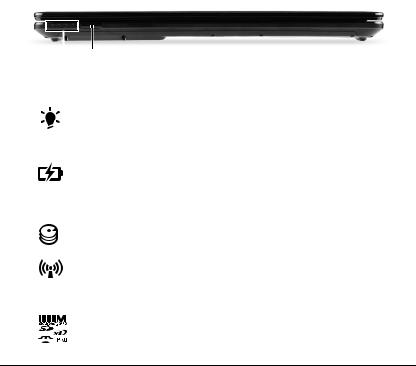
-Note: It is not necessary to press the Fn key to use the F1 to F12 function keys when starting your computer or when using the BIOS.
To swap the hotkey and special function of the F1 to F12 keys, change the function key setting in the BIOS (to open the BIOS press F2 when starting your computer, then select the Main menu and change Function key behavior to Function keys).
FRONT VIEW
|
1 |
2 |
|
|
|
|
|
|
|
# |
Icon |
Item |
Description |
|
|
|
Power indicator |
|
Indicates the computer's power status. |
|
|
|
|
|
|
|
|
|
Indicates the computer's battery status. |
|
|
Battery indicator |
|
- Charging: The light shows amber when the |
|
|
|
battery is charging. |
|
1 |
|
|
|
|
|
|
|
- Fully charged: The light shows blue when in |
|
|
|
|
|
AC mode. |
|
|
|
|
|
|
|
HDD indicator |
|
Indicates when the hard disk drive is active. |
|
|
|
|
|
|
|
Communication |
|
Indicates the computer’s wireless connectivity |
|
|
indicator |
|
device status. |
|
|
|
|
|
|
|
|
|
Accepts Secure Digital (SD), MultiMediaCard |
|
|
|
|
(MMC), Memory Stick PRO (MS PRO), xD- |
2 |
|
Multi-in-1 card reader |
|
Picture Card (xD). |
- Push to remove/install the card. Only one card can operate at any given time.
8 - Quick start guide

LEFT VIEW
|
1 |
2 |
3 |
4 |
5 |
6 |
# |
Icon Item |
|
Description |
|
|
|
|
Kensington lock slot |
Connects to a Kensington-compatible |
||||
|
computer security lock. |
|
||||
|
|
|
|
|||
|
|
|
- Wrap the computer security lock cable |
|||
1 |
|
|
around an immovable object such as a table |
|||
|
|
|
or handle of a locked drawer. |
|||
Insert the lock into the notch and turn the key to secure the lock.
Some keyless models are also available.
2
3
4
5
6
Ventilation and |
Allows the computer to stay cool. |
|
cooling fan |
- Do not cover or obstruct the openings. |
|
|
||
Ethernet (RJ-45) port |
Connects to an Ethernet 10/100/1000-based |
|
network. |
||
|
||
External display |
Connects to a display device (e.g., external |
|
(VGA) port |
monitor, LCD projector). |
|
HDMI port |
Supports high-definition digital video |
|
connections. |
||
|
||
|
Connect to USB devices (e.g., USB mouse, |
|
|
USB camera). |
|
USB port |
- If a port is black, it is USB 2.0 compatible, if |
|
|
||
|
a port is blue (optional) it is also USB 3.0 |
|
|
compatible. |
Getting to know your computer - 9
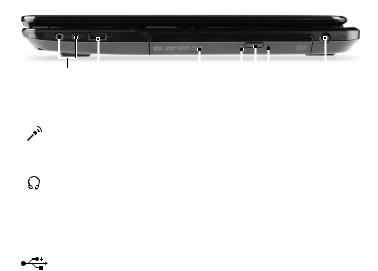
RIGHT VIEW
|
|
|
|
|
|
|
|
|
|
|
|
|
|
|
|
|
|
|
|
|
|
|
|
|
|
|
|
|
|
|
|
|
|
|
|
|
|
|
|
|
|
|
|
|
|
|
|
|
|
|
|
|
|
|
|
|
|
|
|
|
|
|
|
|
|
|
1 |
2 |
3 |
4 5 6 |
7 |
||||||||||||||||
|
|
|
|
|
|
|
|
|
|
|
|
|
|
|
|
|
|
|
|
||
# |
Icon Item |
|
|
Description |
|
|
|
|
|
|
|||||||||||
|
|
|
|
|
|
|
|
Microphone jack |
|
Accepts inputs from external microphones. |
|||||||||||
|
|
|
|
|
|
|
|
|
|
|
|
|
|
|
|
|
|
|
|
||
|
|
|
|
|
|
|
|
|
|
|
|
|
|
Connects to audio line-out devices (e.g., |
|||||||
1 |
|
|
|
|
|
|
|
Headphones / |
|
speakers, headphones). |
|
|
|||||||||
|
|
|
|
|
|
|
|
|
- Supports compatible 3.5 mm headsets with |
||||||||||||
|
|
|
|
|
|
|
|
speaker jack |
|
||||||||||||
|
|
|
|
|
|
|
|
|
|
|
|
|
|
built-in microphone (e.g. |
|
Acer smart |
|||||
|
|
|
|
|
|
|
|
|
|
|
|
|
|
handheld headsets). |
|
|
|||||
|
|
|
|
|
|
|
|
|
|
|
|
|
|
|
|
|
|
|
|
||
|
|
|
|
|
|
|
|
|
|
|
|
|
|
Connect to USB devices (e.g., USB mouse, |
|||||||
|
|
|
|
|
|
|
|
|
|
|
|
|
|
USB camera). |
|
|
|
|
|
|
|
2 |
|
|
|
|
|
|
|
USB port |
|
- If a port is black, it is USB 2.0 compatible, if |
|||||||||||
|
|
|
|
|
|
|
|
|
|
|
|
|
|
||||||||
|
|
|
|
|
|
|
|
|
|
|
|
|
|
a port is blue (optional) it is also USB 3.0 |
|||||||
|
|
|
|
|
|
|
|
|
|
|
|
|
|
compatible. |
|
|
|||||
|
|
|
|
|
|
|
|
|
|
|
|
|
|
|
|
|
|||||
3 |
|
|
|
|
|
|
|
Optical drive |
|
Internal optical drive; accepts CDs or DVDs. |
|||||||||||
|
|
|
|
|
|
|
|
|
|
|
|
|
|
|
|
|
|
|
|||
4 |
|
|
|
|
|
|
|
Optical disk access |
|
Lights up when the optical drive is active. |
|||||||||||
|
|
|
|
|
|
|
indicator |
|
|||||||||||||
|
|
|
|
|
|
|
|
|
|
|
|
|
|
|
|
|
|||||
|
|
|
|
|
|
|
|
|
|
|
|
|
|
|
|
|
|
|
|||
5 |
|
|
|
|
|
|
|
Optical drive eject |
|
Ejects the optical disk from the drive. |
|||||||||||
|
|
|
|
|
|
|
button |
|
|
|
|||||||||||
|
|
|
|
|
|
|
|
|
|
|
|
|
|
|
|
|
|
|
|||
|
|
|
|
|
|
|
|
|
|
|
|
|
|
|
|
|
|
|
|
||
|
|
|
|
|
|
|
|
|
|
|
|
|
|
Ejects the optical drive tray when the computer |
|||||||
6 |
|
|
|
|
|
|
|
Emergency eject |
|
is turned off. |
|
|
|
|
|
|
|||||
|
|
|
|
|
|
|
hole |
|
|
|
- Carefully insert a straightened paper clip to |
||||||||||
|
|
|
|
|
|
|
|
|
|
|
|||||||||||
|
|
|
|
|
|
|
|
|
|
|
|
|
|
||||||||
|
|
|
|
|
|
|
|
|
|
|
|
|
|
eject the optical drive tray. |
|
|
|||||
|
|
|
|
|
|
|
|
|
|
|
|
|
|
|
|
|
|||||
7 |
|
|
|
|
|
|
|
DC-in jack |
|
Connects to your computer’s AC adapter. |
|||||||||||
|
|
|
|
|
|
|
|||||||||||||||
|
|
|
|
|
|
|
|
|
|
|
|
|
|
|
|
|
|
|
|
|
|
10 - Quick start guide
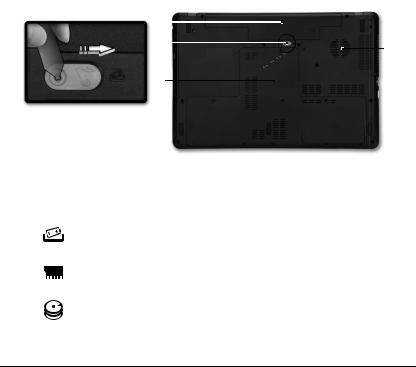
BASE VIEW
1 |
|
|
2 |
4 |
|
|
|
|
|
|
|
3 |
|
|
# |
Icon Item |
Description |
|
1 |
Battery bay |
Houses the computer's battery pack. |
|
|
|
|
|
2 |
Battery release latch |
Releases the battery for removal. Insert a |
|
suitable tool and slide to release. |
|||
|
|
||
|
|
|
|
|
Memory |
Houses the computer's main memory. |
|
|
compartment |
||
3 |
|
||
|
|
||
Hard disk bay |
Houses the computer's hard disk (secured with |
||
|
|||
|
screws). |
||
|
|
||
|
|
|
|
4 |
Ventilation and |
Allows the computer to stay cool. |
cooling fan |
- Do not cover or obstruct the openings. |
|
Getting to know your computer - 11
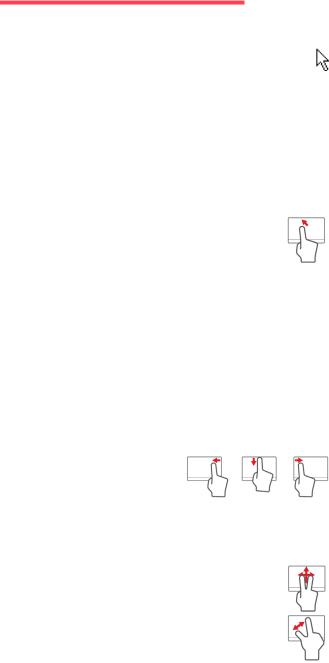
TOUCHPAD
TOUCHPAD BASICS
The touchpad controls the arrow (or 'cursor') on the screen. As you slide your finger across the touchpad, the cursor will follow this movement.
Press the left or right side of the button located beneath the touchpad to perform selection and execution functions. These two areas are similar to the left and right buttons on a mouse. Tapping on the touchpad is the same as clicking the left side of the button.
Note: The touchpad is sensitive to finger movement; the lighter the touch, the better the response.
Please keep the touchpad and your fingers dry and clean.
The cursor is controlled by some basic gestures:
•Single-finger slide: Slide a finger across the touchpad to move the cursor.
•Single-finger tap: Lightly tap the touchpad with your finger, to perform a 'click', which will select or start an item. Quickly repeat the tap to perform a double tap or 'double click'.
•Drag: Press and hold the left side of the selection button, or tap twice anywhere on the touchtap, then slide a second finger across the touchpad to select all items in an area.
TOUCHPAD GESTURES
Windows 8 and many applications support touchpad gestures that use one or more fingers.
Note: Support for touchpad gestures depends on the active application.
These allow you to control applications with a few simple gestures, such as:
•Swipe in from edge: Access Windows tools by swiping into the center of the touchpad from the right, top or left.
•Swipe in from right edge: Toggle the charms.
•Swipe in from top edge: Toggle the app commands.
•Swipe in from left edge: Switch to the previous app.
•Two-finger slide: Swiftly scroll through web pages, documents and playlists by placing two fingers on the touchpad and moving both in any direction.
•Two-finger pinch: Zoom in and out of photos, maps and documents with a simple finger-and-thumb gesture.
12 - Quick start guide

RECOVERY
If you are having trouble with your computer, and the frequently asked questions (see page 82) do not help, you can 'recover' your computer - i.e. return it to an earlier state.
This section describes the recovery tools available on your computer. Packard Bell provides Packard Bell Recovery Management, which allows you to create a recovery backup, a drivers and applications backup, and to start recovery options, either using Windows tools, or the recovery backup.
Note: Packard Bell Recovery Management is only available with a pre-installed Windows operating system.
Important: We recommend that you create a Recovery Backup and Drivers and Applications Backup and as soon as possible. In certain situations a full recovery will require a USB recovery backup.
CREATING A RECOVERY BACKUP
To reinstall from a USB storage drive, you must first create a recovery backup. The recovery backup includes the entire original contents of your computer’s hard drive, including Windows and all factory-loaded software and drivers. Using this backup will restore your computer to the same state as when you purchased it, while giving you an option to retain all settings and personal data.
Note: Make sure you have a USB drive with a capacity of at least 16 GB.
1.From Start, type 'Recovery' and then click Packard Bell Recovery Management in the list of apps.
Recovery - 13
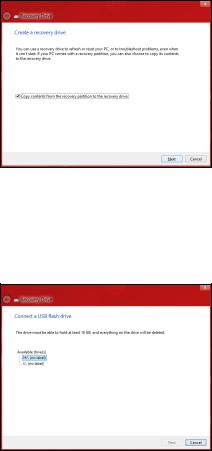
2.Click Create Factory Default Backup. The Recovery Drive window opens.
Make sure Copy contents from the recovery partition to the recovery drive is selected. This provides the most complete and safest recovery backup.
3.Plug in the USB drive then click Next.
•Make sure your USB drive has enough capacity before continuing. The recovery backup requires at least 16 GB of storage
4.You will be shown the backup progress on the screen.
5.Follow the process until it completes.
6.After creating the recovery backup, you can choose to delete the recovery information on your computer. If you delete this information, you can only use the USB recovery backup to restore your computer, if you lose or erase the USB drive, you cannot restore your computer.
14 - Quick start guide
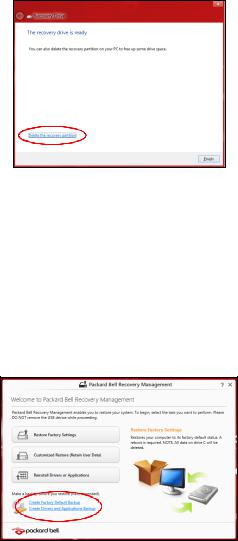
7. Unplug the USB drive and label it clearly.
Important: Write a unique, descriptive label on the backup, such as 'Windows Recovery Backup'. Make sure you keep the backup in a safe place that you will remember.
CREATING A DRIVERS AND APPLICATIONS BACKUP
To create a Drivers and Applications Backup, that contains the factoryloaded software and drivers needed by your computer, you may use either a USB storage drive or, if your computer features a DVD recorder, one or more blank recordable DVDs.
1.From Start, type 'Recovery' and then click Packard Bell Recovery Management in the list of apps.
2.Click Create Drivers and Applications Backup.
Plug in the USB drive or insert a blank DVD into the optical drive, then click Next.
Recovery - 15
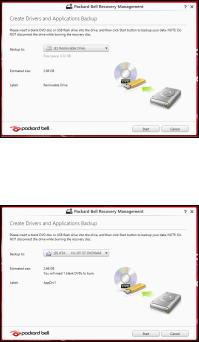
•If you are using a USB drive, make sure your USB drive has enough capacity before continuing.
•If using DVDs, it will also show the number of blank, recordable discs you will need to complete the recovery discs. Make sure that you have the required number of identical, blank discs.
3.Click Start to copy files.You will be shown the backup progress on the screen.
4.Follow the process until it completes:
•If you are using optical discs, the drive ejects each disc as it completes burning it. Remove the disc from the drive and mark it with a permanent marker.
If multiple discs are required, insert a new disc when prompted, then click OK. Continue until the process is complete.
•If you are using a USB drive, unplug the drive and label it clearly.
Important: Write a unique, descriptive label on each backup, such as 'Drivers and Applications Backup'. Make sure you keep the backup in a safe place that you will remember.
RECOVERING YOUR SYSTEM
To recover your system:
1.Perform minor fixes.
If only one or two items of software or hardware have stopped working correctly, the problem may be solved by reinstalling the software or the device drivers.
To reinstall software and drivers that were pre-installed at the factory,
16 - Quick start guide
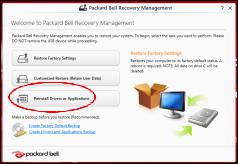
see "Reinstalling drivers and applications" on page 17.
For instructions on reinstalling software and drivers that were not preinstalled, see that product’s documentation or support Web site.
2.Revert to a previous system condition.
If reinstalling software or drivers does not help, then the problem may be solved by returning your system to a previous state when everything was working correctly.
For instructions, see "Returning to an earlier system snapshot" on page 19.
3.Reset your operating system.
If nothing else has solved the problem and you want to reset your system, but keep your user information, see "Returning your system to its factory condition" on page 19.
4.Reset your system to its factory condition.
If nothing else has solved the problem and you want to reset your system to factory condition, see "Returning your system to its factory condition" on page 19.
Reinstalling drivers and applications
As a troubleshooting step, you may need to reinstall the applications and device drivers that came pre-installed on your computer from the factory. You can reinstall using either your hard drive or the backup you have created.
•Other applications - If you need to reinstall software that did not come pre-installed on your computer, you need to follow that software’s installation instructions.
•New device drivers - If you need to reinstall device drivers that did not come pre-installed on your computer, follow the instructions provided with the device.
If you are reinstalling using Windows and the recovery information stored on your computer:
•From Start, type 'Recovery' and then click Packard Bell Recovery Management in the list of apps.
• Click Reinstall Drivers or Applications.
Recovery - 17
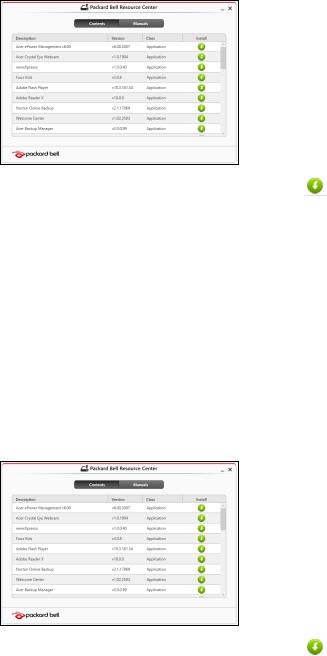
•You should see the Contents section of the Packard Bell Resource Center.
•Click the install icon for the item you want to install, then follow the onscreen instructions to complete the installation. Repeat this step for each item you want to reinstall.
If you are reinstalling from a Drivers and Applications Backup on a DVD or USB drive:
1.Insert the Drivers and Applications Backup into the disc drive or connect it to a free USB port.
•If you inserted a DVD wait for Packard Bell Resource Center to start.
•If Packard Bell Resource Center does not start automatically, press the Windows key + <E>, then double-click on the optical drive icon.
•If you are using a USB drive, press the Windows key + <E>, then double-click on the drive that contains the backup. Double-click on
ResourceCenter.
2.You should see the Contents section of the Packard Bell Resource Center.
3.Click the install icon for the item you want to install, then follow the onscreen prompts to complete the installation. Repeat this step for each item you want to reinstall.
18 - Quick start guide
Returning to an earlier system snapshot
Microsoft System Restore periodically takes a 'snapshot' of your system settings and saves them as restore points. In most cases of hard-to- resolve software problems, you can return to one of these restore points to get your system running again.
Windows automatically creates an additional restore point each day, and also each time you install software or device drivers.
Note: For more information about using Microsoft System Restore, from Start, type 'Help' and then click Help and Support in the list of apps. Type 'Windows system restore' in the Search Help box, then press Enter.
Returning to a restore point
1.From Start, type 'Control Panel' and then click Control Panel in the list of apps.
2.Click System and Security > Action Center, then click Recovery at the bottom of the window.
3.Click Open System Restore, then Next.
4.Click the latest restore point (at a time when your system worked correctly), click Next, then Finish.
5.A confirmation window appears; click Yes. Your system is restored using the restore point you specified. This process may take several minutes, and may restart your computer.
Returning your system to its factory condition
If your computer experiences problems that are not recoverable by other methods, you may need to reinstall everything to return your system to its factory condition. You can recover from either your hard drive or the recovery backup you have created.
•If you can still run Windows and have not deleted the recovery partition, see "Recovering from Windows" on page 19.
•If you cannot run Windows, your original hard drive has been completely re-formatted or you have installed a replacement hard drive, see
"Recovering from a recovery backup" on page 22.
Recovering from Windows
Start Packard Bell Recovery Management:
•From Start, type 'Recovery' and then click Packard Bell Recovery Management in the list of apps.
Recovery - 19
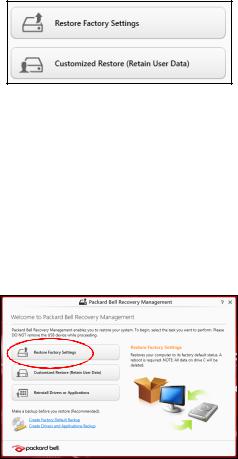
Two options are available, Restore Factory Settings (Reset my PC) or
Customized Restore (Refresh my PC).
Restore Factory Settings deletes everything on your hard drive, then reinstalls Windows and all software and drivers that were pre-installed on your system. If you can access important files on your hard drive, back them up now. See "Restore Factory Settings with Packard Bell Recovery Management" on page 20.
Customized Restore will attempt to retain your files (user data) but will reinstall all software and drivers. Software installed since you purchased your PC will be removed (except software installed from the Windows Store). See "Customized Restore with Packard Bell Recovery Management" on page 21.
Restore Factory Settings with Packard Bell Recovery Management
1. Click Restore Factory Settings.
Caution: 'Restore Factory Settings' will erase all files on your hard drive.
2.If your computer is configured with two operating systems (only available on certain systems), a window opens with the option to restore either Windows 7 or Windows 8. If you choose Windows 7, your computer will restart and restore Windows 7. If you choose Windows 8, Reset your PC opens, as described below.
Note: To fully enjoy Windows 8 features after changing from Windows 7, enter the BIOS (press <F2> when starting your computer) and change Boot Mode to UEFI. If you reinstall Windows 7, you must change Boot Mode back to Legacy before restarting your computer.
20 - Quick start guide
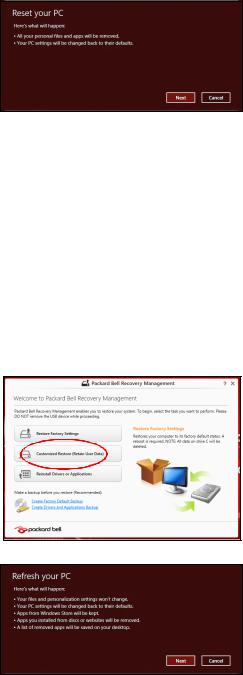
3. The Reset your PC window opens.
Images for reference only.
4.Click Next, then choose how to erase your files:
a.Just remove my files quickly erases all files before restoring your computer and takes about 30 minutes.
b.Fully clean the drive completely cleans the drive after each file is erased, so no files can be viewed after the recovery. Cleaning the drive takes much longer, up to 5 hours, but is much more secure as old files are completely removed.
5.Click Reset.
6.The recovery process begins by restarting your computer, then continues by copying files to your hard drive.
7.After the recovery has finished, you can start using your computer by repeating the first-start process.
Customized Restore with Packard Bell Recovery Management
1. Click Customized Restore (Retain User Data).
2. The Refresh your PC window opens.
3. Click Next, then Refresh.
Recovery - 21
4.The recovery process begins by restarting your computer, then continues by copying files to your hard drive. This process takes about 30 minutes.
Recovering from a recovery backup
To recover from a recovery backup on a USB drive:
1.Find your recovery backup.
2.Plug in the USB drive and turn on your computer.
3.If it is not already enabled, you must enable the F12 Boot Menu:
a.Press <F2> when starting your computer.
b.Use the left or right arrow keys to select the Main menu.
c.Press the down key until F12 Boot Menu is selected, press <F5> to change this setting to Enabled.
d.Use the left or right arrow keys to select the Exit menu.
e.Depending on the type of BIOS your computer uses, select Save Changes and Exit or Exit Saving Changes and press Enter. Select
OK or Yes to confirm.
f.Your computer will restart.
4.During startup, press <F12> to open the boot menu. The boot menu allows you to select which device to start from, select the USB drive.
a.Use your arrow keys to select USB Device, then press Enter.
b.Windows starts from the recovery backup instead of the normal startup process.
5.Select your keyboard type.
6.Select Troubleshoot and then choose the type of recovery to use:
a.Click Advanced then System Restore to start Microsoft System Restore:
Microsoft System Restore periodically takes a 'snapshot' of your system settings and saves them as restore points. In most cases of hard-to-resolve software problems, you can return to one of these restore points to get your system running again.
b.Click Reset your PC to start the reset process:
Reset your PC deletes everything on your hard drive, then reinstalls Windows and all software and drivers that were pre-installed on your system. If you can access important files on your hard drive, back them up now. See "Reset your PC from the recovery backup" on page 23.
c.Click Refresh your PC to start the refresh process:
Refresh your PC will attempt to retain your files (user data) but will reinstall all software and drivers. Software installed since you purchased your PC will be removed (except software installed from the Windows Store). See "Refresh your PC from the recovery backup" on page 23.
22 - Quick start guide
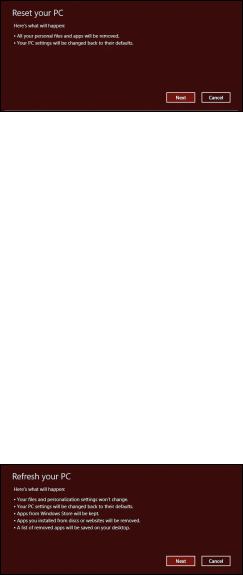
Reset your PC from the recovery backup
Caution: Reset your PC will erase all files on your hard drive.
1. The Reset your PC window opens.
Images for reference only.
2.Click Next.
3.Select the operating system to recover (normally only one option is available).
4.Choose to keep any changes to the hard drive:
a.If you have deleted the recovery partition or otherwise changed the partitions on the hard drive and want to keep these changes, select No.
b.To completely restore your computer to Factory Settings, select Yes.
5.Choose how to erase your files:
a.Just remove my files quickly erases all files before restoring your computer and takes about 30 minutes.
b.Fully clean the drive completely cleans the drive after each file is erased, so no files can be viewed after the recovery. Cleaning the drive takes much longer, up to 5 hours, but is much more secure as old files are completely removed.
6.Click Reset.
7.After the recovery has finished, you can start using your computer by repeating the first-start process.
Refresh your PC from the recovery backup
1. The Refresh your PC window opens.
2.Click Next.
3.Select the operating system to recover (normally only one option is available).
4.Click Refresh.
5.The recovery process begins by restarting your computer, then continues by copying files to your hard drive. This process takes about 30 minutes.
Recovery - 23

REGULATORY INFORMATION
PREVENTION OF HEARING LOSS
-Caution: Permanent hearing loss may occur if earphones or headphones are used at high volume for prolonged periods of time.
-A pleine puissance, l’écoute prolongée du baladeur peut endommager l’oreille de l’utilisateur.
CAUTION when listening:
To protect your hearing, follow these instructions.
-Increase the volume gradually until you can hear clearly and comfortably.
-Do not increase the volume level after your ears have adjusted.
-Do not listen to music at high volumes for extended periods.
-Do not increase the volume to block out noisy surroundings.
-Decrease the volume if you can’t hear people speaking near you.
RADIO DEVICE REGULATORY NOTICE
-Note: Regulatory information below is for models with wireless LAN and/or Bluetooth only.
WIRELESS ADAPTER REGULATORY INFORMATION
USA — FCC and FAA
The FCC with its action in ET Docket 96-8 has adopted a safety standard for human exposure to radio frequency (RF) electromagnetic energy emitted by FCC certified equipment. The wireless adapter meets the Human Exposure limits found in OET Bulletin 65, supplement C, 2001, and ANSI/IEEE C95.1, 1992. Proper operation of this radio according to the instructions found in this manual will result in exposure substantially below the FCC’s recommended limits.
-The following safety precautions should be observed:
Do not touch or move antenna while the unit is transmitting or receiving.
-Do not hold any component containing the radio such that the antenna is very close or touching any exposed parts of the body, especially the face or eyes, while transmitting.
-Do not operate the radio or attempt to transmit data unless the antenna is connected; this behavior may cause damage to the radio.
Use in specific environments:
-The use of wireless adapters in hazardous locations is limited by the constraints posed by the safety directors of such environments.
-The use of wireless adapters on airplanes is governed by the Federal Aviation Administration (FAA).
-The use of wireless adapters in hospitals is restricted to the limits set forth by each hospital.
Antenna Use
In order to comply with FCC RF exposure limits, low gain integrated antennas should be located at a minimum distance of 20 cm (8 inches) or more from the body of all persons or at a minimum distance as specified by the FCC module grant conditions. FCC grants can be viewed from the FCC Equipment Authorization website at https://fjallfoss.fcc.gov/ oetcf/eas/reports/GenericSearch.cfm by entering the FCC ID printed on the module label.
24 - Quick start guide
Explosive Device Proximity Warning
Warning: Do not operate a portable transmitter (including this wireless adapter) near unshielded blasting caps or in an explosive environment unless the transmitter has been modified to be qualified for such use
Antenna Warnings
-Warning: To comply with the FCC and ANSI C95.1 RF exposure limits, it is recommended that for the wireless adapter installed in a desktop or portable computer, the antenna for this wireless adapter to be installed so as to provide a separation distance of at least 20 cm (8 inches) from all persons or at the minimum distance as specified by the module grant conditions. FCC grants can be viewed from the FCC Equipment Authorization website at https://fjallfoss.fcc.gov/oetcf/eas/ reports/GenericSearch.cfm by entering the FCC ID printed on the module label.
-Warning: The wireless adapter is not designed for use with high-gain directional antennas.
Use On Aircraft Caution
-Caution: Regulations of the FCC and FAA prohibit airborne operation of radiofrequency wireless devices (wireless adapters) because their signals could interfere with critical interfere with critical aircraft instruments.
Local Restrictions on 802.11a, 802.11b, 802.11g and 802.11n Radio Usage
-Caution: Due to the fact that the frequencies used by 802.11a, 802.11b, 802.11g and 802.11n wireless LAN devices may not yet be harmonized in all countries, 802.11a, 802.11b, 802.11g and 802.11n products are designed for use only in specific countries, and are not allowed to be operated in countries other than those of designated use. As a user of these products, you are responsible for ensuring that the products are used only in the countries for which they were intended and for verifying that they are configured with the correct selection of frequency and channel for the country of use. Any deviation from the permissible power and frequency settings for the country of use is an infringement of national law and may be punished as such.
Wireless Interoperability
The wireless adapter is designed to be interoperable with other wireless LAN products that are based on direct sequence spread spectrum (DSSS) radio technology and to comply with the following standards:
-IEEE Std. 802.11b compliant Standard on Wireless LAN
-IEEE Std. 802.11g compliant Standard on Wireless LAN
-IEEE Std. 802.11a compliant Standard on Wireless LAN (applies to devices supporting 802.11a)
-IEEE Std. 802.11n draft 2.0 compliant on Wireless LAN
-Wireless Fidelity certification, as defined by the Wi-Fi Alliance
The Wireless Adapter and Your Health
The wireless adapter, like other radio devices, emits radio frequency electromagnetic energy. The level of energy emitted by the wireless adapter, however, is less than the electromagnetic energy emitted by other wireless devices such as mobile phones. The wireless adapter operates within the guidelines found in radio frequency safety standards and recommendations. These standards and recommendations reflect the consensus of the scientific community and result from deliberations of panels and committees of scientists who continually review and interpret the extensive research literature. In some situations or environments, the use of the wireless adapter may be restricted by the proprietor of the building or responsible representatives of the applicable organization. Examples of such situations may include:
Regulatory information - 25
-Using the wireless adapter on board airplanes, or
-Using the wireless adapter in any other environment where the risk of interference with other devices or services is perceived or identified as being harmful.
If you are uncertain of the policy that applies to the use of wireless adapters in a specific organization or environment (an airport, for example), you are encouraged to ask for authorization to use the adapter before you turn it on.
FCC Radio Frequency Interference Requirements (applies to device supporting 802.11a)
This device is restricted to indoor use due to its operation in the 5.15 to 5.25 GHz and 5.470 to 5.725 GHz frequency ranges. FCC requires this product to be used indoors for the frequency ranges 5.15 to 5.25 GHz and 5.470 to 5.725 GHz to reduce the potential for harmful interference to co-channel mobile satellite systems. High power radars are allocated as primary users of the 5.25 to 5.35 GHz and 5.65 to 5.85 GHz bands. These radar stations can cause interference with and /or damage this device. No configuration controls are provided for this wireless adapter allowing any change in the frequency of operations outside the FCC grant of authorization for U.S operation according to Part 15.407 of the FCC rules.
USA — Federal Communications Commission (FCC)
This device complies with Part 15 of the FCC Rules. Operation of the device is subject to the following two conditions:
-This device may not cause harmful interference.
-This device must accept any interference that may cause undesired operation.
-Note: The radiated output power of the adapter is far below the FCC radio frequency exposure limits. Nevertheless, the adapter should be used in such a manner that the potential for human contact during normal operation is minimized. To avoid the possibility of exceeding the FCC radio frequency exposure limits, you should keep a distance of at least 20 cm between you (or any other person in the vicinity), or the minimum separation distance as specified by the FCC grant conditions, and the antenna that is built into the computer. Details of the authorized configurations can be found at http://www.fcc.gov/oet/ea/ by entering the FCC ID number on the device.
Interference Statement
This wireless adapter has been tested and found to comply with the limits for a Class B digital device, pursuant to Part 15 of the FCC Rules. These limits are designed to provide reasonable protection against harmful interference in a residential installation. This wireless adapter generates, uses, and can radiate radio frequency energy. If the wireless adapter is not installed and used in accordance with the instructions, the wireless adapter may cause harmful interference to radio communications. There is no guarantee, however, that such interference will not occur in a particular installation. If this wireless adapter does cause harmful interference to radio or television reception (which can be determined by turning the equipment off and on), the user is encouraged to try to correct the interference by taking one or more of the following measures:
-Reorient or relocate the receiving antenna of the equipment experiencing the interference.
-Increase the distance between the wireless adapter and the equipment experiencing the interference.
-Connect the computer with the wireless adapter to an outlet on a circuit different from that to which the equipment experiencing the interference is connected.
-Consult the dealer or an experienced radio/TV technician for help.
26 - Quick start guide
-Note: The adapter must be installed and used in strict accordance with the manufacturer's instructions as described in the user documentation that comes with the product. Any other installation or use will violate FCC Part 15 regulations.
Canada — Industry Canada (IC)
This device complies with RSS210 of Industry Canada. Cet appareil se conforme à RSS210 de Canada d'Industrie.
-Caution: When machine supports and using IEEE 802.11a wireless LAN, this product is restricted to indoor use due to its operation in the 5.15to 5.25 GHz frequency range. Industry Canada requires this product to be used indoors for the frequency range of 5.15 GHz to 5.25 GHz to reduce the potential for harmful interference to co-channel mobile satellite systems. High power radar is allocated as the primary user of the 5.25 to 5.35 GHz and 5.65 to 5.85 GHz bands. These radar stations can cause interference with and/or damage to this device. The maximum allowed antenna gain for use with this device is 6dBi in order to comply with the E.I.R.P limit for the 5.25 to 5.35 and 5.725 to 5.85 GHz frequency range in point-to- point operation. To comply with RF exposure requirements all antennas should be located at a minimum distance of 20 cm, or the minimum separation distance allowed by the module approval, from the body of all persons.
-Attention: l’utilisation d’un réseau sans fil IEEE802.11a est réstreinte à une utilisation en intérieur à cause du fonctionement dans la bande de fréquence 5,15 - 5,25 GHz. Industry Canada requiert que ce produit soit utilisé à l’intérieur des bâtiments pour la bande de fréquence 5,15 - 5,25 GHz afin de réduire les possibilités d’interférences nuisibles aux canaux co-existants des systèmes de transmission satellites. Les radars de puissances ont fait l’objet d’une allocation primaire de fréquences dans les bandes 5,25 - 5,35 GHz et 5 65 - 5 85 GHz. Ces stations radar peuvent créer des interférences avec ce produit et/ou lui être nuisible. Le gain d’antenne maximum permissible pour une utilisation avec ce produit est de 6 dBi afin d’être conforme aux limites de puissance isotropique rayonnée équivalente (P.I.R.E.) applicable dans les bandes 5,25 - 5,35 GHz et 5,725 - 5,85 GHz en fonctionement point-à-point. Se pour conformer aux conditions d'exposition de RF toutes les antennes devraient être localisées à une distance minimum de 20 cm, ou la distance de séparation minimum permise par l'approbation de module, du corps de toutes les personnes.
This Class B digital apparatus complies with Canadian ICES-003.
Cet appareil numérique de la classe B est conforme a la norme NMB-003 du Canada.
"To prevent radio interference to the licensed service, this device is intended to be operated indoors and away from windows to provide maximum shielding. Equipment (or its transmit antenna) that is installed outdoors is subject to licensing."
« Pour empêcher que cet appareil cause du brouillage au service faisant l'objet d'une licence, il doit être utilisé a l'intérieur et devrait être placé loin des fenêtres afin de fournir un écran de blindage maximal. Si le matériel (ou son antenne d'émission) est installé à l'extérieur, il doit faire l'objet d'une licence. »
European Union
List of applicable countries
This product must be used in strict accordance with the regulations and constraints in the country of use. For further information, contact the local office in the country of use. Please see http://ec.europa.eu/enterprise/rtte/implem.htm for the latest country list.
Regulatory information - 27

List of National Codes
THIS EQUIPMENT MAY BE OPERATED IN THE FOLLOWING COUNTRIES:I
|
ISO 3166 |
|
ISO 3166 |
|
ISO 3166 |
|
ISO 3166 |
Country |
2 letter |
Country |
2 letter |
Country |
2 letter |
Country |
2 letter |
|
code |
|
code |
|
code |
|
code |
Austria |
AT |
Germany |
DE |
Malta |
MT |
United Kingdom |
GB |
|
|
|
|
|
|
|
|
Belgium |
BE |
Greece |
GR |
Netherlands |
NT |
Iceland |
IS |
|
|
|
|
|
|
|
|
Cyprus |
CY |
Hungary |
HU |
Poland |
PL |
Liechtenstein |
LI |
|
|
|
|
|
|
|
|
Czech Republic |
CZ |
Ireland |
IE |
Portugal |
PT |
Norway |
NO |
|
|
|
|
|
|
|
|
Denmark |
DK |
Italy |
IT |
Slovakia |
SK |
Switzerland |
CH |
|
|
|
|
|
|
|
|
Estonia |
EE |
Latvia |
LV |
Slovenia |
SL |
Bulgaria |
BG |
|
|
|
|
|
|
|
|
Finland |
FI |
Lithuania |
LT |
Spain |
ES |
Romania |
RO |
|
|
|
|
|
|
|
|
France |
FR |
Luxembourg |
LU |
Sweden |
SE |
Turkey |
TR |
|
|
|
|
|
|
|
|
The low band 5.15 -5.35 GHz is for indoor use only.
This equipment complies with the essential requirements of the European Union directive 1999/5/EC. See Statements of European Union Compliance, and more details refer to the attached Declaration of Conformity.
|
Hereby, ACER INC., declares that this devise is in |
|
English |
compliance with the essential requirements and other |
|
|
relevant provisionns of Directive 1999/5/EC. |
|
|
|
|
|
ACER INC. tímto prohlašuje, že toto zařízení je ve shodě se |
|
Česky [Czech] |
základními požadavky a dalšími příslušnými ustanoveními |
|
|
směrnice 1999/5/ES. |
|
|
|
|
|
Undertegnede ACER INC. erklærer herved, at følgende |
|
Daansk [Danish] |
udstyr overholder de væsentlige krav og øvrige relevante krav |
|
|
i direktiv 1999/5/EF. |
|
|
|
|
|
Hiermit erklärt ACER INC., dass sich das Gerät Radiolan in |
|
Deutsch |
Übereinstimmung mit den grundlegenden Anforderungen und |
|
[German] |
den übrigen einschlägigen Bestimmungen der Richtlinie |
|
|
1999/5/EG befindet. |
|
|
|
|
|
Käesolevaga kinnitab ACER INC. seadme vastavust direktiivi |
|
Eesti [Estonian] |
1999/5/EÜ põhinõuetele ja nimetatud direktiivist tulenevatele |
|
|
teistele asjakohastele sätetele. |
|
|
|
|
|
Por medio de la presente ACER INC. declara que el |
|
Español |
dispositivo cumple con los requisitos esenciales y |
|
[Spanish] |
cualesquiera otras disposiciones aplicables o exigibles de la |
|
|
Directiva 1999/5/CE. |
|
|
|
|
Ελληνικά |
∆ια του παρόντος η ACER INC. δηλώνει ότι η παρούσα |
|
συσκευή συµµορφώνεται προς τις ουσιώδεις απαιτήσεις και |
||
[Greek] |
||
τις λοιπές διατάξεις της Οδηγίας 1999/5/ ΕΚ. |
||
|
||
|
|
28 - Quick start guide
